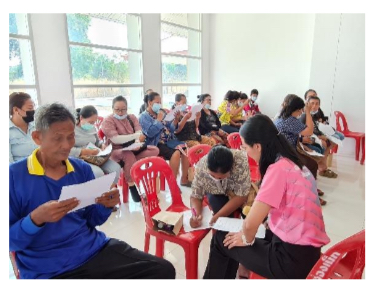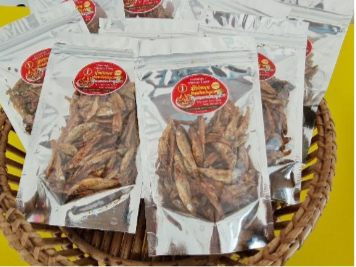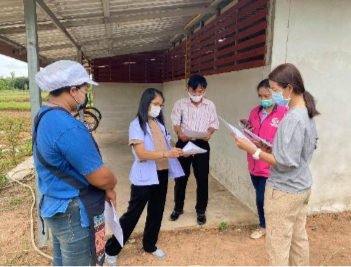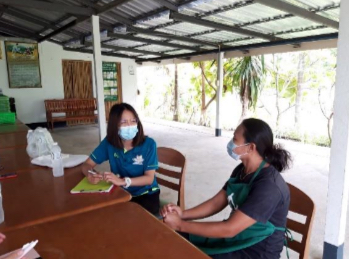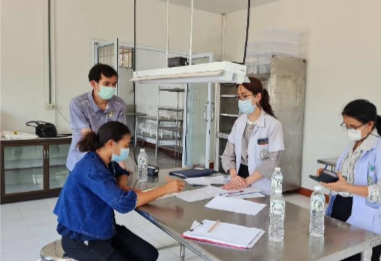การสร้างสูตรมาตรฐานและพัฒนาศักยภาพการผลิตปลาซิวแก้วสามรสอบกรอบ
บทคัดย่อ/Abstract
การวิจัยนี้มีวัตถุประสงค์ เพื่อสร้างสูตรมาตรฐานสำหรับผลิตภัณฑ์ปลาชิวแก้วอบกรอบ เพื่อพัฒนาผลิตภัณฑ์ด้านคุณภาพสินค้า และเพื่อพัฒนาขีดความสามารถของกลุ่มวิสาหกิจด้านการจัดการสถานที่ผลิตอาหารให้เป็นไปตามหลักเกณฑ์และวิธีการผลิตที่ดี โดยได้ทำการศึกษาความชอบของผู้บริโภคจากผลิตภัณฑ์ปลาซิวแก้วสามรสที่ผลิตในชุมชน จำนวน 3 สูตร พบว่าตัวอย่างที่ 1 ได้รับ เลือกให้เป็นผลิตภัณฑ์ต้นแบบ เนื่องจากมีคะแนนการประเมินตามความชอบโดยรวมสูงที่สุด มีคะแนนความชอบด้าน กลิ่น รสชาติ สมุนไพร ความกรอบ เนื้อสัมผัส และความชอบโดยรวมสูงที่สุดโดยมีคะแนน 7.00 7.46 7.34 6.98 7.08 และ 7.54 ตามลำดับ จากนั้นจึงได้ทำการพัฒนาผลิตภัณฑ์โดยแปรปริมาณส่วนผสม 4 สูตรเปรียบเทียบกับสูตรควบคุม (ผลิตภัณฑ์ต้นแบบ) พบว่า สูตรที่พัฒนาขึ้นมีค่าปริมาณไขมันต่ำกว่าสูตรควบคุมและมีปริมาณโปรตีนสูงกว่าสูตรควบคุมอย่างมีนัยสำคัญทางสถิติ (Ps0.05) มีค่าความชื้นอยู่ระหว่างร้อยละ 4.88 ถึง 7.21 มีค่าปริมาณเถ้าอยู่ระหว่างร้อยละ 8.98 ถึง 9.8 7 และมีปริมาณน้ำอิสระอยู่ระหว่าง 0.32 ถึง 0.41 ผลิตภัณฑ์ที่พัฒนาขึ้นมีค่า L" และ b* ไม่แตกต่างจากสูตรควบคุมและมีค่า ล* สูงกว่าสูตรควบคุมอย่างมีนัยสำคัญ(Ps0.05) ผลิตภัณฑ์สูตรที่ 2 มีค่าความแข็งไม่แตกต่างจากสูตรควบคุม (P>0.05) และมีค่าความกรอบสูงกว่าสูตรควบคุม (P s0.05) ตัวอย่างควบคุมมีค่าเพอร์ออกไซด์สูงที่สุดตั้งแต่สัปดาห์แรกของการเก็บรักษาไปจนถึงสัปดาห์ที่ 8 ส่วนตัวอย่างสูตรที่ 1 และ 2 มีค่าไม่แตกต่างกัน (ยกเว้นสัปดาห์ที่ 6 ส่วนตัวอย่างที่ 3 และ 4 มีค่าใกล้เคียงกัน ทั้งนี้การที่สูตร 1 และ 2 มีค่าเพอร์ออกไชด์ต่ำที่สุดใน สัปดาห์สุดท้ายของการเก็บรักษาการศึกษาการยอมรับผลิตภัณฑ์ พบว่า ผู้บริโภคให้การยอมรับสูตรที่พัฒนาขึ้นสูตรที่ 2 สูงที่สุดและมากกว่าสูตรควบคุมอย่างมีนัยสำคัญ (Ps0.05) โดยมีค่าความชอบในระดับชอบมากผู้บริโภคให้การยอมรับผลิตภัณฑ์ต้นแบบที่พัฒนาขึ้นโดยมีความต้องการซื้อ (ร้อยละ 40) โดยซื้อสัปดาห์ละ 1 ครั้ง (ร้อยละ 34) และซื้อครั้งละ 1 ถุง (ร้อยละ 42) ดังนั้นจึงได้คัดเลือกสูตรที่ 2 เป็นสูตรมาตรฐานในงานวิจัยนี้การวิเคราะห์คุณค่าทางโภชนาการในตัวอย่างผลิตภัณฑ์ปลาแก้วสามรสสูตรมาตรฐาน 100 กรัม ให้พลังงานทั้งหมด 402.00 กิโลแคลอรี พลังงานจากไขมัน 126.54 กิโลแคลอรี ไขมันทั้งหมด 14.06 กรัม ไขมันอิ่ มตัว 5.52 กรัม โคเลสเตอรอล 234.31 มิลลิกรัม โปรตีน 38.37 กรัม คาร์โบไฮเดรตทั้งหมด 30.55 กรัม โซเดียม 1104.91 มิลลิกรัม แคลเซียม 1427.16 มิลลิกรัม เหล็ก 2.538 มิลลิกรัม ตรวจไม่พบ วิตามินเอ วิตามินบี 1 และวิตามินบี 2 การพัฒนาขีดความสามารถของกลุ่มวิสาหกิจด้านการจัดการสถานที่ผลิตอาหารให้ เป็นไป ตามหลักเกณฑ์และวิธีการผลิตที่ดี จากงานวิจัยนี้สามารถแก้ไขปัญหาด้านสูตรมาตรฐานที่ผู้บริโภคให้ การยอมรับ โดยมีการศึกษาวิจัยทดสอบกับผู้บริโภค แก้ไขปัญหาด้านกรรมวิธีการผลิตให้ได้มาตรฐานโดยมีการระบุชนิดของเครื่องมือ สูตรที่เหมาะสม อุณหภูมิและระยะเวลาในการผลิต แก้ไขปัญหาด้าน การรับรองสถานที่ผลิต โดยการส่งเสริมให้ความรู้ให้คำแนะนำการจัดทำเอกสารที่เกี่ยวข้องจนเกิดการ พัฒนาขึ้นอย่างเป็นรูปธรรม อีกทั้งานวิจัยนี้ได้มีการส่งเสริมความรู้ที่เกี่ยวข้อง ผ่านการอบรมและการให้คำปรึกษาข้อมูลผ่านช่องทางออนไลน์โดยตรงกับวิสาหกิจชุมชน ยังผลให้ชุมชนเกิดการพัฒนาและสามารถยกระดับรายได้ของชุมชนได้ในอนาคต
The present study aims to create standardized formulas of Thai river sprat snack product, to develop product quality and to develop competence of community enterprises management of food production sites to have good production standards. The studying consumer preferences from 3 community products It was found that sample 1 was chosen as the prototype product. Because it has the highest overall rating. They had the highest scores on odor, taste, herbs, crispness, texture and overall liking, with scores of 7.00, 7.46, 7.34, 6.98, 7.08 and 7.54 respectively. The development new product by varying the amount of 4 ingredients compared to the control formula, it was found that the developed formula had lower fat content than the control and protein content was higher than the control (P≤0.05), with moisture content between 4.88 to 7.21%. The ash content ranged from 8.98 to 9.87% and the aW was between 0.32 to 0. 41. The developed product had L* and b* values not different from the control formulations and a* value significantly higher than the control formulation. The hardness of the second formula was not different from the control (P>0.05) and the crispness was higher than the control (P≤0. 05). The control sample had the highest peroxide value from the first week of preservation until 8th week, whereas for formula 1 and 2, the values were not different. (Except 6th week), formula 3 and 4 were similar. However, formulas 1 and 2 had the lowest peroxide values in the last week of storage. The product acceptance study revealed that the consumer's acceptance of the second developed formulation was the highest and was significantly higher than the control formula (P≤0. 05), with a preference at the very favorable level. Consumers accepted the prototype developed with a purchase demand (40%), buying once a (4) week (34%) and buying 1 bag at a time (42%). Therefore, the second formula was selected as the standard formula in this research. Nutritional analysis of 100 g standard formula products, total energy 402.00 kcal, energy from fat 126.54 kcal, total fat 14.06 g, saturated fat 5.52 g, cholesterol 234.31 mg, protein 38.37 g, total carbohydrate 30.55 g, sodium 1104.91 mg, calcium 1427.16 mg, iron 2.538 mg, not detectable vitamin A, vitamin B1 and vitamin B2. Development competence of community enterprises management of food production sites to have good production standards. From this study can be solved the problem of product formulas to consumer acceptant. Solve problems in production methods to be standardized by specifying the type of equipment. suitable formula, set temperature and production time. Solve problems with certification of production sites by promoting knowledge and advice on the preparation of relevant documents until the development is concrete Moreover, this research has promoted relevant knowledge. through training and information consulting through online channels directly to community enterprises as a result, the community can develop and can raise the income of the community in the future.

